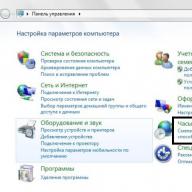Good day to all!
The breakdown of a laptop, most often, occurs suddenly, when we are not expecting it. It seems that only yesterday everything was in order with him, he worked, but in the morning he does not turn on from anything ...
There are a lot of questions in this category (especially now that laptops have become more popular than conventional desktop PCs). In general, since many users usually do not very specifically describe the problem, I immediately want to say that the laptop may not "turn on" in different ways:
- may not react at all to any pressing, not "blink" LEDs, etc .;
- or it can react to the power button, reach the OS boot and show some kind of error.
Actually, based on this, I will build an article. I will consider below the various options, and what can be done in each to restore work. The article, if it does not repair your equipment, will help to understand the problem and save a certain amount of money ...
Important note
First, don't panic! Much more damage can be done by hasty action. In some cases, you can solve the problem yourself. Try to remember after which it happened, what happened the day before, whether there were any errors, installed any software, etc. Sometimes, it helps a lot in solving!
By the way, I will immediately add that if your laptop is under warranty, I do not recommend opening it, removing the hard drive, and generally performing any manipulations. All this can lead to a denial of warranty service!
Important note!
 Very often the laptop does not turn on due to a dead battery.
Very often the laptop does not turn on due to a dead battery.
Moreover, I note that even if you just charged it a couple of hours ago, this is not a guarantee that it could not sit down (for example, a laptop could independently wake up from sleep mode, start a system update, and drain the battery in the process. , this is not uncommon).
I'm not even talking about not providing the necessary currents for the full operation of the device.
If the laptop does not respond at all to any taps, none of the LEDs are on ...
This problem often occurs due to a lack of power. Let's go through the steps that need to be checked and done:

In principle, if all of the above did not help, then it is difficult to advise something else in this case. I recommend taking your laptop to the service for diagnostics. The cause of the breakdown can be, as well as complete nonsense (the power supply wiring departed - a penny repair), or a rather serious reason, for example, a burned-out microcircuit on the mat. board ...
If the LEDs light up, the laptop is noisy, but there is no image on the screen
- first of all I recommend connecting an external screen to your laptop and see if there will be an image on it. If there is - the problem is probably related to the laptop monitor, if not - then most likely there are problems with the video card or mat. device board.
- then note: the screen is always black, or when turned on, it still blinks (for a second or two), and then the image disappears. If at first the image is visible, and as soon as Windows starts loading, it disappears, most likely the problem lies in the "broken" system (see the next subsection of this article);
- then take a close look on the screen surface: The backlight often burns out and nothing is visible on the screen. Try to shine a flashlight or a table lamp on the screen - you may see a picture (an example is presented below). On average, the backlight repair is not that expensive (besides, it is not uncommon when the reason for this lies in the wear of the loop, the cost of which is a penny ...).

- on some laptops there are special function keys to turn off the screen (moreover, there are laptops that remember this enabled setting even after restarting the device!). For example, on ASUS laptops, this is a combination of buttons Fn + F7.

- if to laptop recently connected an external monitor- it is possible that the signal transmission mode "Only to an external monitor" is activated. Try using specials. keys (the screenshot above shows a photo of an ASUS laptop keyboard - a combination of Fn + F8 buttons) .
- often the problem lies in a decayed discrete video card(for example, due to overheating). Overheating often occurs in hot summer weather, with a strong load on the laptop (for example, various games), while often the laptop has not been cleaned of dust for a long time. Often, in this case, the laptop turns off right during the game (or reboots, but the picture is no longer on the screen). In this case, the problem with the video card is most likely;
- if you have two video cards(discrete + integrated) - then you can try to disable one of them in the BIOS (unless, of course, at the stage of turning on the laptop, you have an image on the screen). You can find out how to configure the BIOS and disable the discrete video card here: Pay attention to the parameter Graphic Device Settings (allows you to turn off the discrete card and work only on the built-in one);
- it is also not uncommon when on the screen instead of an image, various artifacts
: ripples, stripes, etc. In some cases, you can restore yourself, in others - not. More on this here:

If instead of loading Windows, a black screen is shown with some inscriptions (errors)
If, after turning on, the laptop immediately turns off or restarts
- disconnect everything you can from the laptop: mouse, external drive, headphones, etc .;
- Pay attention to the battery: if the battery is worn out, then its capacity may not be enough for the full operation of the laptop. Try to connect the power adapter (it will also not be superfluous to test the laptop without a battery);
- such symptoms are also characteristic of device overheating: if there is something wrong with the cooling system (with the CPU or video card), then when Windows boots up, the temperature can start to rise sharply and the laptop turns off, in order to protect itself (in this case, the cooler inside the device should work noisily). The topic of overheating is quite extensive, I recommend that you read the material of this article: ;
- by the way, rebooting the device can also be related to damage to Windows, virus infection, etc. For testing, I recommend that you try - if the download takes place in normal mode and everything works, then most likely the problem is related to the currently installed Windows operating system;
- maybe the problem is related with contact closure on the mat. device board (for example, when USB ports, HDMI ports burn out. Also, contacts are often short-circuited with some kind of liquid). Remember, the day before, did you connect any devices: were there any errors, or a small spark?
Of course, I haven't considered a lot, but on such a streamlined question, it's probably quite difficult to do this. Having run through the options presented above, you can cut off and eliminate some of the reasons due to which the laptop could not turn on ...
All the best!
Laptop manufacturers take into account the fact that the devices they supply are high-tech and the likelihood of malfunctions in their work is quite high. That is why almost all notebooks are equipped with simple diagnostic tools to quickly find and diagnose problems. Moreover, in most cases, the user can restore the device to work on his own. The hardest part is to establish the original cause of the failure. How to determine why the laptop does not turn on and what can be done in this situation?
The laptop does not turn on - we find out the reasons
Many modern laptops are equipped with a basic I / O system (except for the Chromebook, which uses a less functional "bootloader"). This is the so-called BIOS, some models use an add-on over it - UEFI (in fact, the same BIOS, but with a more convenient and colorful menu). What it is? This is a small firmware that is embedded into the motherboard. Its main purpose is to scan all devices connected to the board and diagnose them.
 In most cases, the user can restore the device to work by himself.
In most cases, the user can restore the device to work by himself.
What happens when the user presses the power key? A startup signal is given in the BIOS. That, in turn, scans all connected equipment (determines the brand and type of processor, the amount of installed RAM, the video adapter model, the model of the north and south bridges, tests the display, the presence of a network interface, keyboard, mouse, touchpad, etc.) ... If the BIOS does not find any errors, it searches for a bootloader on the hard disk and, if found, transfers control of the device to it. Then Windows starts (or another installed OS - Linux, MacOS, Android, BSD, etc.).
From the above, we can conclude:
- if at startup the user sees the manufacturer's logo, and then the OS starts loading, then the BIOS performed diagnostics and did not find any faults with the installed hardware;
- if the OS does not start loading, but at the same time a service message is displayed on the display, then this indicates either the absence or damage of the hard disk, or that the diagnostics have not been completed - one of the components is not working correctly;
- if there is no reaction to pressing the power button, the BIOS does not receive a startup signal, which indicates a malfunction with the power system.
All this allows you to determine the type of problem due to which the laptop does not start. They are conventionally divided into:
- Software (system). When an error is caused by a software glitch and the hardware is working properly.
- Hardware. When the error is caused by a malfunction of any equipment connected to the motherboard.
It is with the definition of the type of error that you should start diagnosing the breakdown in order to understand why the laptop does not turn on. The simplest rule is:
- if there is a reaction to pressing the power button and the fan noise is heard, this is more likely a software failure;
- if there is no reaction at all to pressing the button (including the glow of the LED indicators), this is most likely a hardware error.
The user can deal with almost all software errors on his own without contacting the service center. With hardware, the situation is somewhat more complicated, and it is far from always possible to do without the help of a qualified specialist.
Diagnostics and elimination of software errors
The first step is to clarify that the BIOS is also a kind of operating system, although its functionality is rather small. And failures in the operation of this OS also often occur, therefore, its operation should be diagnosed. Other common software errors may include:
- damage to the OS bootloader;
- damage to system files or OS kernel;
- failure of software hardware drivers (most often graphics drivers "fail").
BIOS problems
As a rule, in such cases, the laptop starts up and issues a service message about problems. In some cases, the image does not appear at all. The easiest way to rule out a BIOS problem is to reset it to factory defaults. To do this, you need to find a CR2032 battery on the motherboard and remove it for a few seconds (then be sure to put it back). This turns off the power to the volatile CMOS memory, where it is stored outside the BIOS settings. In most laptop models, this battery is located directly under the bottom cover or under the keyboard - the information should be clarified in the service documentation (or just watch the video on disassembling a certain laptop model). If resetting the BIOS settings did not fix the startup problem, then you should check the operation of the hard disk and the OS.
 It is necessary to find a CR2032 battery on the motherboard and remove it for a few seconds
It is necessary to find a CR2032 battery on the motherboard and remove it for a few seconds
Graphics Accelerator Driver Issues
The video adapter driver is responsible for its correct operation in the environment of the installed operating system (Windows, Linux, MacOS, etc.). In case of malfunctions in its operation, the image on the display may simply not be displayed (or it will disappear at the stage of loading the OS). How to check if the driver is working? There are two options:
- connect an external monitor;
- run the OS in "Safe Mode".
An external monitor must be connected via a VGA, HDMI or DVI output, depending on the specifications of the laptop. The connection must be made with the monitor and laptop turned off, otherwise both the display and the graphics adapter can be damaged.
 Press the F8 key and select "Safe Mode"
Press the F8 key and select "Safe Mode" If connecting an external monitor did not bring any result (that is, the image did not appear on it), then you should try to start the OS in "Safe Mode". For this:
- when turning on the laptop, press the F8 key;
- after the list of boot options appears, select "Safe Mode".
If we are talking about a laptop with Linux installed, then it must be started with the "nomodeset" parameter (enter this line in the GRUB parameters by pressing the "E" key).
As a rule, when booting in "Safe Mode", the driver built into the OS is used, so the monitor resolution, as well as its color palette, will be "default".
If the OS was loaded successfully in Safe Mode, you will need to manually remove the installed video adapter driver and install a compatible one (by downloading it from the manufacturer's website or taking it from the disk that comes with the laptop).
If, when trying to start, an error is displayed about the absence of a bootloader, then this indicates a damaged entry in the MBR or GPT directory of the hard disk, where information about the installed OS and a short algorithm for starting system files are stored. Most often this happens due to the trivial wear and tear of the hard drive or damage to system files when the laptop is turned off improperly (when the battery was removed during operation or the power adapter was disconnected).
How do I fix the problem? The first step is to try to restore the bootloader with the built-in OS tools. But this will require a Windows installation disc or flash drive. So, to restore the bootloader you will need:
- at the stage of starting the laptop, press the F11 key (in some models - F12, F2, Tab);
- from the list of devices that appears, select a disk or flash drive with Windows Installer;
- wait for the installation menu to appear and select "System Restore".
After that, the installer will try to independently detect the malfunction with the OS installed on the hard disk and fix it. If the MBR or GPT is trivially damaged, it helps. If, after automatic diagnostics, a notification appears that the program was unable to restore Windows boot, then this indicates damage not only to the bootloader, but also to the system files, kernel and Windows partition. In such cases, only reinstalling the operating system will help.
 To solve the problem, you need an installation disc or flash drive with Windows
To solve the problem, you need an installation disc or flash drive with Windows It is also worth noting that an error about the absence of an OS (Operation System not found) may indicate that not a hard disk was selected as the main boot device, but, for example, a floppy drive or a USB flash drive inserted into the USB port. To fix this error you will need:
- at the stage of starting the laptop, press the F11 key (to access the boot menu);
- select a hard disk as a device for loading (as a rule, this line should contain the designation HDD, SATA or ST).
If a laptop has 2 hard drives installed (many "gaming" laptops have both an SSD drive and a traditional HDD installed at the same time), then you should boot from each of them one by one.
Reinstalling the system
This is the most radical, but at the same time, the most reliable way to eliminate software errors in the operating system. You should use it if the bootloader cannot be restored. You will need either an installation disc or a Windows flash drive for this. You can download a trial version of Windows (with a trial period for 30 days) on the official Microsoft website https://support.microsoft.com/windows. The ISO images of the installation discs will be offered there. You should download the appropriate one, and then:
- or burn the image to a DVD. Any program for burning discs like Ashampoo Burning Studio, Nero, Ultra ISO and the like will do;
- or write the image to a flash drive. You will need a flash drive with a size of 8 gigabytes or more. The easiest tool to use is Rufus. Although it is not recommended by Microsoft, it can itself determine the type of operating system being written, and it also allows you to choose the type of disk partitioning - MBR or GPT. You can download it on the official website https://rufus.akeo.ie. The Russian version of the utility is also available.
 Reinstalling the OS will help solve many software problems
Reinstalling the OS will help solve many software problems - after pressing the power button, press the F11 key;
- select the required drive from the list that appears;
- following the instructions of the installer - install the operating system (select "Install", not "Update").
If the user has a license code for the edition of Windows being installed, it can be entered at the installation stage.
Laptop hardware breakdown
With hardware breakdowns, everything is somewhat more complicated. Most of them cannot be eliminated at home, and one cannot do without the advice of a qualified specialist. Therefore, it is worth considering only the most commonplace breakdowns, due to which the laptop may not start, and at the same time, the user can fix them on his own.
No power
In this case, when you press the power button, there will be no reaction at all from the device. The indicators will not light up, and the fans will not start either. There are several reasons for this:
- not installed, missing or damaged battery;
- not connected, power supply is faulty;
- the contacts of the start button are physically damaged.
To eliminate these malfunctions, you should:
- Check if the battery is securely inserted (it should be trivial to disconnect it, wipe the contacts with alcohol, install it back after drying). If possible, check the voltage at the battery terminals. Otherwise, it must be replaced; for this, contact an authorized service center.
- Check the power supply. Most of them have an LED indicator for operation. You should check if the plug is inserted into the outlet, the connector is in the power supply itself, the connector is in the laptop's power connector. If there is a suspicion of a unit malfunction (it does not heat up, there is a burning smell from it), then it should be replaced.
To check the contacts of the physical button, you will need to disassemble the case and "ring" it with a multimeter for breaks.
Malfunction of the video card
Quite a common problem on those laptops that are actively used for games. The main symptom is the absence of an image on the display, the appearance of graphic artifacts, the video card gives an error in the device manager (as a rule, error code 43). Elimination of the malfunction is possible by the following methods:
- replacing the graphics adapter (if it is connected via the MXM port on the motherboard);
- soldering a working GPU chip.
In any case, you will have to contact the service center. Unfortunately, the cost of such a repair is about 50 - 75% of the cost of a new laptop, so in most cases it is impractical. Another thing is when it comes to a device under warranty.
Hard drive failure
In this case, the hard disk is either not displayed in the boot devices, or an error is displayed on it when trying to install the OS (due to the presence of bad sectors). The first step is to remove the hard drive and wipe its contacts with alcohol - quite often the device is not recognized precisely because of the presence of oxides on them. If no reaction follows, then you should replace the hard drive with a compatible one (in most cases it is SATA 2.5 inches).
Why does my laptop keep shutting down and restarting?
The most common reasons for this are:
- malfunction of RAM;
- overheating of the motherboard (processor, graphics accelerator, north and / or south bridges, multicontroller);
- malfunction of the power supply or battery (the current emitted by it sags in voltage or its current strength is insufficient for the normal operation of the laptop).
RAM diagnostics is carried out using the Memtest program. If no errors are detected in this case, and a malfunction of the battery or power supply is excluded, then most likely the reason is overheating. To eliminate it, you must:
- clean the cooling system from dust;
- replace thermal grease on the processor, graphics chip, north and south bridges, multicontroller (depending on the laptop configuration);
- replace all thermal pads installed in the laptop (they are usually installed on memory chips integrated into the motherboard or graphics adapter);
- lubricate the cooler with silicone oil.
And to check the current temperature regime of laptop components, you can use the AIDA64 program (https://www.aida64.com/downloads - here is a demo version, limited in time). Typically, the normal operating temperature for all notebooks under load is between 45 and 80 degrees. If it is higher, then to protect against failure, the device simply shuts down in emergency mode. This is why the laptop either shuts down or reboots.
Video: how to identify faults if the laptop does not turn on
In total, there are many reasons why a laptop may not start. The most common ones are discussed above. If it was not possible to fix the malfunction on his own or the user simply does not want to do this, you should contact the official service centers. You can get acquainted with their list either in the warranty card for the laptop, or on the manufacturer's website.
Laptops have become part of the life of a modern person. Like any other technique, they sometimes break. When it stopped turning on, then you should not panic, but you should find the cause and eliminate it. In most cases, you will be able to restore your computer to work.
Causes of malfunction and their solutions
There can be a huge number of reasons why the laptop does not actually turn on. Many of them are quite simple and it will not be difficult to fix them on your own, but with some problems you will have to contact the service center.
Let's take a look at the main reasons a mobile computer may stop starting:

Comment. Very often, people who say that the PC does not turn on at all mean that Windows does not boot. This is not entirely correct reasoning, but it is popular among ordinary users.
Power problems
Power problems very often cause the PC to stop starting. Although the problem seems serious, in most cases it is easy enough to diagnose and fix it at home.
Major power problems:
- incorrect adapter connection;
- damage to cables and connectors;
- battery malfunction;
- breakdown of the power supply;
- problems in the food chain.
Often, with such problems, the power indicator of the laptop does not light up. First of all, you should check that the power supply is connected correctly and that it is plugged into an outlet. It is worth noting that even very experienced users may forget to connect the PC to the network. As a result, after the battery is discharged, the device stops starting.

Damage to power cords and connectors can be caused by a variety of reasons, including rough handling or pets that chew on the cord. You can check this malfunction using an external inspection.
Another very common problem is related to the battery. In some cases, if it does not work, then the PC stops turning on even with the network adapter connected. Usually, after pressing the power button, even the cooler does not work. Therefore, it is worth trying to run the mobile computer on AC power without a battery.
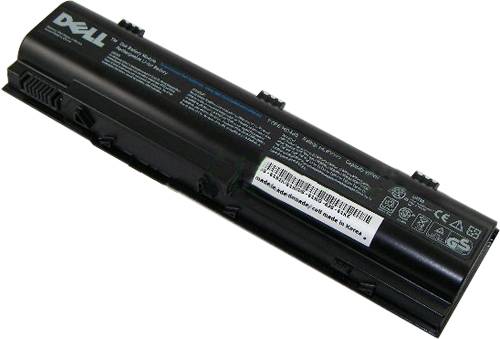
The power supply fails quite often for any device. Without a charger, the laptop battery will run out sooner or later, after which the computer will stop turning on. It is very easy to check if the network adapter is working. It is enough to connect another charger from a known working computer.

Many power supplies are equipped with an indicator. Even if the light is on, it is impossible to completely eliminate problems with the network adapter. It is worth noting that there are many power supplies for laptops. Only adapters suitable for a particular model should be connected to a computer.
Power failure problems are much less common, but they are more serious. In this case, it will not be possible to independently diagnose and even more so fix the problem. You need to contact the specialists from our service center. Leave a request and you will be called back within a few minutes.

Defective hard drive
The hard drive stores all the information and the operating system of the computer. If it malfunctions, the computer can be turned on, but it freezes before the Windows splash screen appears. In some cases, an HDD error message may appear, for example, information that the disk is not a system one.

In any case, the user still has the opportunity to enter the BIOS SETUP menu. There you can check if the hard disk is detected and the correctness of the settings. If the hard drive is visible, then you can start the system from a boot disk or flash drive and test it.
Failure of the video card and chipset microcircuits
Laptop components can also fail. This can be caused by overheating, impact damage, and so on.
Let's take a look at the details that most often cause problems with turning on the PC:
- south bridge;
- north bridge;
- video card.

In this case, the behavior of the computer can be very different. If the video card is out of order, then the image will be absent, but the fan will work and sometimes even Windows will boot, making the appropriate sound. If one of the bridges is out of order, the computer may not turn on at all or stop before loading the OS.
It is almost impossible to establish the reason in this case on your own. And an attempt at home repair is likely to only hurt. Therefore, it is better to use the services of a service center.
Video: The laptop does not turn on. Diagnostics of the board.
Other reasons
In fact, the malfunction may lie in a number of other problems. Among which are the following:
- damage to the processor or memory;
- broken BIOS firmware;
- overheat;
- errors in Windows.
If the PC beeps when turned on, then this indicates in most cases overheating or problems with the RAM. If you have little experience, you can try to find out on your own why this is happening. To do this, it is necessary, first of all, to remove the dust. If the problem persists, you can replace the memory modules with known good ones.

Broken BIOS firmware may result from an incorrect update. If, before the problem occurred, the user tried to carry out this operation, then he will have to contact for repair.
BIOS configuration errors are also common. It is very easy to solve this problem on your own by simply going to the SETUP menu and loading the default settings, for example, by selecting the Load Setup Defaults option.
Errors in the work of Windows can lead to the fact that the OS does not start. First of all, you need to find out their cause and try to solve it. Alternatively, you can try reinstalling the operating system or restoring it from the factory.
The laptop does not turn on at all
Very often, the laptop will not turn on at all due to power problems. But ? The power button is lit after pressing and nothing further happens. We'll have to look for the cause and eliminate it.
Typical actions that cause a laptop to stop turning on:
- dust cleaning;
- update;
- overheat.

If errors were made during the cleaning or updating process, then the behavior of the computer can be very different. Including the start may not occur at all. In addition, the system may not turn on due to problems with the hard disk and after overheating.
After cleaning
There are situations when, after cleaning, the laptop stops turning on. The fan may start or a squeak may be heard. On some models, the indicators also start flashing.
Cleaning a laptop involves disassembling it. The first thing to do is to disassemble it again and check the connection of all components, as well as the installation of the cooling system. It will be useful to pay attention to the thermal paste and the health of the tubes that serve for heat removal.

If the RAM modules were removed during the cleaning process, then you should try to remove them again, clean the contacts and reinstall them. You also need to check if the laptop starts with the hard disk and optical drive disconnected.
It is worth paying attention to the sensor for opening the lid (display) when disassembling again. If not very neatly assembled, it can be out of place.

If the implementation of simple tips did not lead to results and the device still does not work, then you should contact the service center. It is possible that the elements were damaged by static electricity or some other problem occurred during disassembly.
After update
Problems may occur during the update. Failure to install updates correctly may cause your computer to stop turning on.
In this case, the user can install a new version of the BIOS, drivers or patches for the operating system.
The most difficult case is the inability to start the computer after updating the BIOS. This happens when the user tried to interfere with the process, for example, by restarting or shutting down the computer during it, or when using unofficial firmware.

Of course, it won't be superfluous to reset the settings to the standard ones. This can be done by removing the battery for a few minutes or by closing the corresponding jumper on the motherboard. But as practice shows, this probably will not help to fix the problem. The only way out is to contact the service center for repair.
In a situation where errors started after installing driver updates or Windows, you can simply roll back to a previous restore point from Safe Mode, reinstall the operating system, or return to the state it was at when you purchased it, if this feature is available in the model.
Hard drive defective
Usually, when a hard disk fails, the start occurs, but the system simply freezes at the manufacturer's logo or displays information that the disk is not a system one or is damaged.

If the hard drive is defined in SETUP, then you can independently perform its diagnostics by booting from removable media and running a specialized utility, for example, Victoria. In case of confirmation of the worst fears or the impossibility of identifying the device in the BIOS, it is necessary to check the loop.
In extreme cases, you need to replace the hard drive yourself or with the help of our specialists, to do this, click the "Order a call" button.

After overheating
Modern computers generate a lot of heat during operation. In case of severe dustiness or a malfunction of the cooling system, overheating may occur, after which some parts may fail. As a rule, it is impossible to solve the problem on your own; you will have to contact the service center for this.
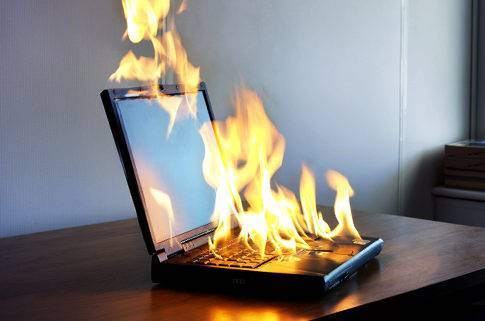
The main parts that can fail as a result of overheating:
- CPU;
- video card;
- HDD;
- north and south bridges.
Spontaneous shutdowns
In some cases, the computer may turn on and even work normally for a while. Then a spontaneous shutdown occurs. There are several main reasons for this.

Consider the typical problems that lead to the shutdown of the device without any indication from the user:
- overheat;
- malfunction of parts;
- viruses;
- software errors.
Overheating is the most common reason for random shutdowns and reboots of mobile PCs, which in the future can lead to device breakdown. In order to avoid this, it is necessary to regularly remove dust, and also sometimes change the heat-conducting paste.

Malfunction of parts very often also occurs due to overheating. If there were no regular cleanings, then the likelihood of this is high. You will not be able to solve such a problem on your own. Therefore, you should contact our specialist immediately.

Viruses can lead to incorrect operation of the system, as a result of which the PC can turn itself off. To solve this, you need to download special utilities from the Doctor Web site or Kaspersky Lab, perform a full scan and remove threats.
Software errors also often lead to an arbitrary shutdown of the laptop. You need to find the reason using the code that appears on the screen at the time of the failure. After that, the problematic application should be uninstalled or try to update to the latest version.
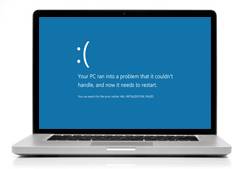
Checking for battery problems is straightforward. You need to remove it, connect the charger and start the laptop. If the glitches are gone, then the battery needs to be replaced.
It turns on, but ...
In some cases, the PC may turn on, but the download will stop at a certain point. At the same time, error messages may appear on the screen. In some cases, Windows does not start, in others it even fails to initialize.
Initialization fails
Initialization occurs at the time of starting the PC before proceeding to boot Windows. If the indicators light up, the cooler turns on, but there is no access to the hard disk (the corresponding light does not light up), then with a high probability the initialization failed.
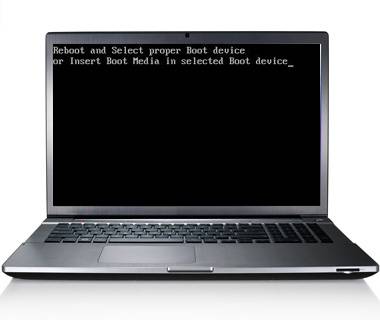
Possible reasons why the laptop may not initialize:
- malfunction of the processor, memory or video card;
- incorrect BIOS firmware;
- defects or damage to the south silt of the north bridge.
Regardless of the reason, you will have to carry your PC to a service center. Only a specialist with the necessary equipment in this case will be able to accurately determine the cause of the problem and eliminate it.

Windows won't start
Failure to start Windows in most cases does not indicate a hardware problem. Therefore, you can try reinstalling it, roll back to the previous state of the PC, or use the manufacturer's recovery tools.

In the hardware part, most often the inability to boot the OS is associated with hard disk problems. In this case, it will have to be replaced. Previously, you can try to diagnose with special utilities by booting from removable media.
There are a lot of laptop malfunction options. You can diagnose and eliminate many of them yourself at home, but in case of a serious breakdown, you still have to contact the specialists of our service center.
Wherein. Why it happens? What should you pay attention to? What may be required in order to rectify the situation? Understanding the questions posed is not as easy as it seems. After all, a computer is an unpredictable hardware. Malfunctions, especially when turning on, can be the result of many failures. Some go straight to service centers. This is not recommended. It is advisable to first try to diagnose the problem yourself. Maybe it will be possible to cope with the situation without outside help.
Video card
Power light is on, laptop won't turn on? The reasons for this phenomenon are different. The first thing to think about is a video card malfunction. In the case of a stationary computer, it is easy to detect and fix a breakdown or failure - just remove this component and connect it to another machine.
But in the case of laptops, you have to try. It is recommended that if you suspect a breakdown or malfunction of the video card, contact the service centers for help. Or call some system administrator. You can also try to diagnose the problem yourself. Usually the laptop turns on by itself - you can hear the cooler. But there is no picture on the screen. Sometimes you can even hear the loading of the operating system.
Screen malfunction
What's next? The power indicator is on, the laptop does not turn on, but can I exclude it? It is likely that the monitor is broken or damaged. An extremely rare occurrence that still takes place in practice.
If the display is broken, then, most likely, the "symptoms" of the breakdown will be exactly the same as in the case of the video card. There will be no images on the monitor, but the sound of turning on the operating system will appear.

It will not be possible to solve this problem on your own. If only by purchasing a new laptop. In such circumstances, you can contact the service center. Maybe the display can be repaired. But usually the devices after such a repair do not work for a long time. In the end, you will still have to replace the laptop with a new one.
"Bios"
The following situation can be corrected without assistance. Power light is on, laptop won't turn on? The main reasons for this phenomenon are either a failure or a reset.
It is likely that the BIOS settings are out of order. This caused the problem under study on the laptop. In this situation, it is recommended that you completely reset the BIOS. After that, the computer should work at full strength.

Lack of ingredients
What else can be a consequence of the problem? If we are talking about a new laptop that has not worked before, do not rule out the absence of any components. If the machine itself turns on, but nothing is displayed on the screen, and the CapsLock and NumLock buttons do not go out, most likely the BIOS does not initialize.
It is likely that the laptop does not have a processor or RAM. Or, when it comes to a previously functioning device, the reason may lie in the breakdown of the listed components.
HDD
Sometimes it happens that although the power indicator is on, the laptop does not turn on, but previously it worked normally, the cause of the problem is the hard drive. A small glitch - and the computer will refuse to start. But at the same time, the power button will be lit. You may also notice that the fan is operating normally. Buttons "Nam Lok" and others light up and go out, as expected.
It is recommended to disassemble the laptop and disconnect the hard drive. In this state, try to turn on the device again. Did not help? Then you can neatly reattach the component. If the problem lay in a failure, then now it will disappear.
Battery
Power light is on, laptop won't turn on? Diagnosing an incident requires certain knowledge from the user. Yes, you shouldn't take your computer for repair right away. But it should be borne in mind that most problems are usually solved with the help of a professional.

You can solve the situation on your own if, for example, the problem lies in the battery. It is likely that she is discharged. Then it is enough to connect the power (wire) to the network and to the machine. Then try to turn on the device again. It is best to wait a few minutes before pressing the laptop's power button. Let the battery get some power. This technique turns out to be quite effective.
Some people recommend removing the battery from the laptop completely and then reconnecting the power cord. Only then turn on the computer and watch the situation. If the machine is working at full capacity, then nothing else needs to be done. Otherwise, you will have to look for the source of the problem elsewhere.
As practice shows, battery problems or a discharged laptop are common. Perhaps the safest and most easily removable without assistance.
Closures
Samsung laptop won't turn on? The power indicator is on, is the cooler working? The next scenario is one of the rarest. And it is almost impossible to diagnose it on your own.

The problem under study may appear when the south or north bridge is damaged in a laptop. Why does this happen? Bridge problems are caused by different methods. For example, by a short circuit due to temperature differences. If, say, a USB port is damaged on a laptop because of this, it is likely that the problem under study will appear.
There is only one method of struggle - the repair of damaged components. The most efficient way is to buy a new computer. After all, on laptops, rarely repaired components work for a long time. Here, each user independently decides what to do.
Viruses
If the laptop does not turn on (the power indicator is on) after the device has been operating for some time, you should think about the impact on the machine of viruses. Computer infection often leads to the fact that the computer stops working normally. Sometimes it comes to BIOS damage by viruses. Accordingly, there will be a problem with turning on the laptop.
It is unlikely that you will be able to fix the problem on your own. As with most of the previously mentioned cases, it is best to take your computer to a service center. There they will help not only to restore the laptop's performance, but also cure it from viruses.
Fortunately, this scenario is quite rare. But it should not be ruled out. Especially if the user himself admits the presence of viruses in the computer. Sometimes problems with turning on the laptop appear after the operating system has been disinfected. Then it is enough to reinstall the "BIOS" first, then the OS. After that, no problems will bother you anymore.

Instead of a conclusion
What can be summed up? It should be noted that in most cases, both diagnostics and troubleshooting are reduced to contacting a service center. Most often, many do this. After all, a laptop is an extremely complex device. It is not as easy to repair it yourself as a stationary analogue.
If you figure out why it didn't work out, you can immediately contact specialized centers. If there is any suspicion of a specific problem, it is imperative to inform the service employees about it.


